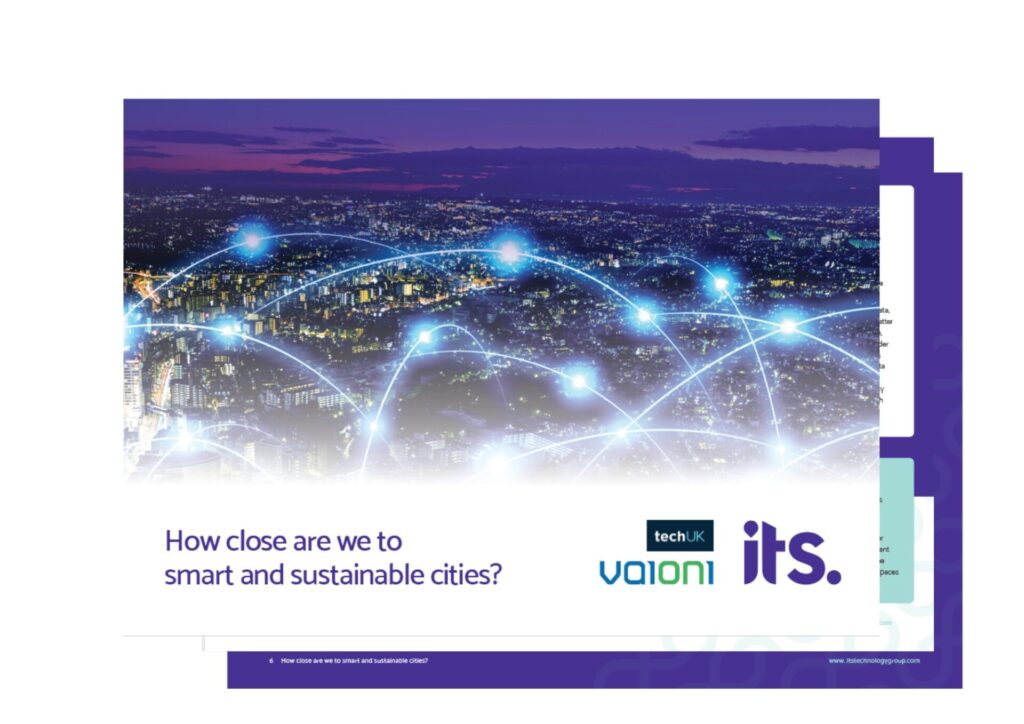UKREiiF Smart Cities

The evolving definition of ‘smart’ and how close we are to a truly sustainable smart future
The UK’s rapid digital transformation progress has evolved how we view ‘smart’ as a tool for connecting people and businesses with sustainable, streamlined infrastructure. But as the UK Government positions itself to become a leader in AI, and smart technology is deployed to meet nationwide Net Zero targets as well as improving public infrastructure, it begs the question – how close are we to a truly smart, sustainable future?
Certainly, the principle of ‘smart’ has evolved in recent years from a technology-focused term to a holistic tool that encompasses social inclusivity, environmental responsibility, and fiscal streamlining tools – with data as a catalyst. To understand the true impact and how close we are to a unified smart future, ITS conducted a roundtable at UKREiiF 2024 with public/private sector leaders and created an educational whitepaper from the insights gathered. Below provides a glimpse of the key takeaways.
The UK picture against the global stage
London, Singapore and New York are stark examples of densely built urban areas embracing the ‘smart’ concept to transform public services and champion sustainability.
- Singapore: Their Smart Nation Initiative uses robust ICT infrastructure to optimise urban planning, water management, energy efficiency and urban mobility.
- London: As the economic centre of the UK, London’s smart city initiatives alongside The London Datastore drives innovation, providing open data to promote transparency. This is coupled with a dedicated Chief Digital Officer and the Smart London Board and Emerging Technology Charter to drive forward the capital’s commitment to emissions reduction. This programme of activity is exemplified by London’s electric bus scheme, and bike-sharing programs to optimise transportation portfolios.
- New York: New York is also embracing smart technology to navigate complex public infrastructure, including its LinkNYC project offering free Wi-Fi. This pairs with the Big Apple’s Green New Deal to achieve a more resilient, greener urban environment.
How is this driving future trends
After examining the international space, there are a few interesting trends emerging…
- Artificial Intelligence and Machine Learning
- Circular Economy Principles
- Enhanced Citizen Engagement
- Place-Based Thinking
- Urban environments and sustainable principles
Combining these emerging trends and global perspectives, we’re likely to see a transformation of urban environments to enhance the quality of life for urban inhabitants. Machine Learning, Artificial Intelligence, and Renewable Energy Sources will result in the full integration of Smart Grids to enable efficient energy distribution. It’s expected that this is turn will encourage further use of electric vehicles and clean energy use. These initiatives enable ‘Smart Cities and Streets’ which provide the future resilience to withstand the impacts of climate change, encouraging urban farming and green architecture to achieve food and climate security.
Additionally, the role of IoT and the underlying fibre infrastructure in social care and wellbeing is increasingly prominent within smart city development. Recent discussions with consultants have highlighted how IoT-connected homes and buildings can contribute to key priorities such as:
- Safety: Ensuring windows and doors are shut and secured for vulnerable residents and council premises.
- Assurance: Smart health devices, motion, heat, and noise sensors can monitor vulnerable and elderly individuals’ health and wellbeing, enabling targeted and proactive social care.
- Integrated Services: Linking healthcare services with IoT-enabled homes ensures individuals can be safely discharged into controlled, monitored environments, improving patient outcomes.
- Infrastructure Maintenance: Water and damp sensors allow councils to monitor housing stock and public assets such as libraries, schools, and council buildings, enabling proactive maintenance strategies and clear ROI models.
As cities and councils increasingly rely on these technologies, the demand for high-quality, reliable connectivity becomes ever more critical to ensuring the successful deployment and integration of smart initiatives.
The Smart Cities and Streets Requirements
To reap the full benefit of Smart Cities and Streets, it hinges on the following factors…
People engagement
Active participation from people across from citizens and authorities is essential to effective execution. Stakeholders should include:
- Innovation Teams
- Planning Teams
- Procurement Teams
- Transport Teams
Place and Space
Place and space must be considered as part of a smart future to avoid the patchwork quilt effect. This means that smart technology must provide unified solutions that benefit every region of the UK – catering to the unique needs of each local authority.
Public and Private Sector Collaboration
Private and public sector collaboration is essential to fully integrate advanced technologies, ensuring a wide range of voices throughout the planning process, to guarantee that smart cities and streets deliver mutual benefits for the private and public sectors.
Environmental and Sustainability Efforts
The key pillar of smart cities and streets is ultimately achieving a more environmentally sustainable future, with smart infrastructure such as EV charging stations and environmental monitoring devices crucial for meeting net zero targets. It’s estimated that commercial buildings should decrease their emissions from about 120 to below 50 kgCO2eq/m2 per year by 2030. Looking further ahead, the aim is to reach nearly zero by 2050 to achieve climate security, and smart technology is key to this, through HVAC (heating, ventilation and cooling) optimisation, occupancy monitoring and smart windows.
Download our ‘How close are we to smart and sustainable cities’ whitepaper
From the above information, the UK, while having made dramatic progress toward a more sustainable, smart city future – there is still a considerable way to go to reap the full benefits of smart cities and streets. To understand how a smarter future can lead to a more secure, prosperous, and streamlined nation, download ITS’ explorative whitepaper to find out more.